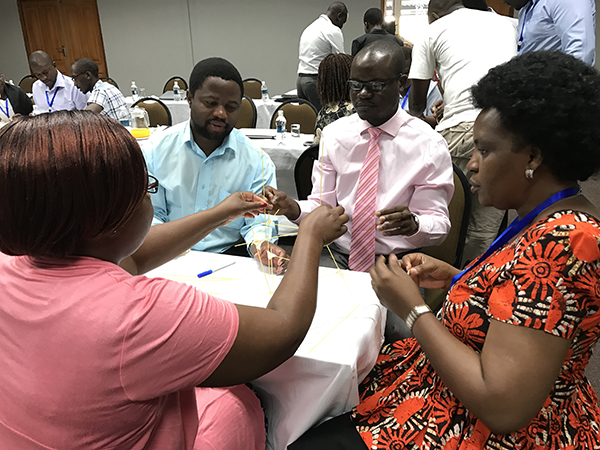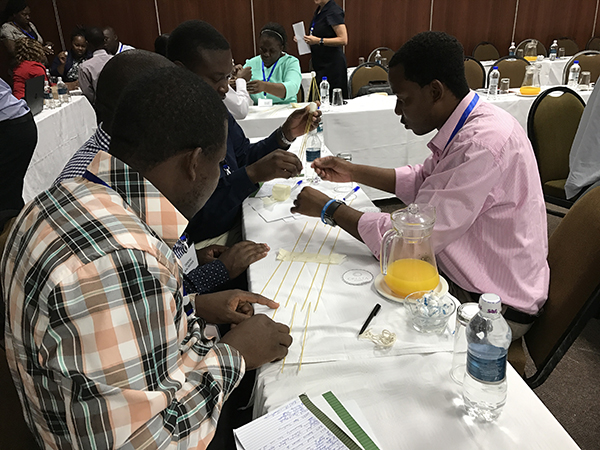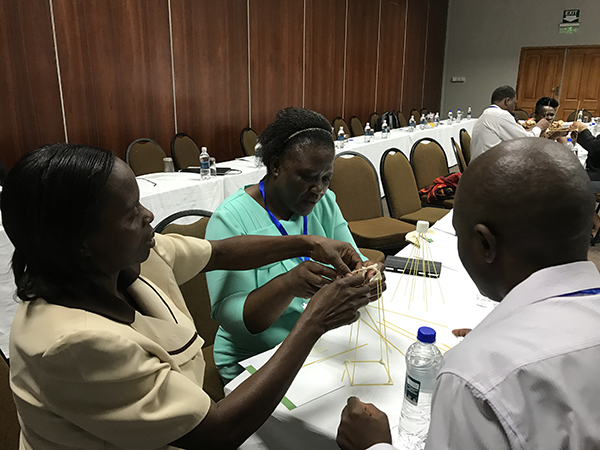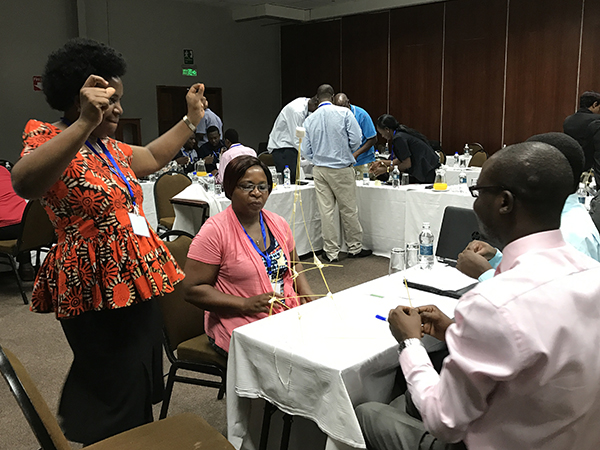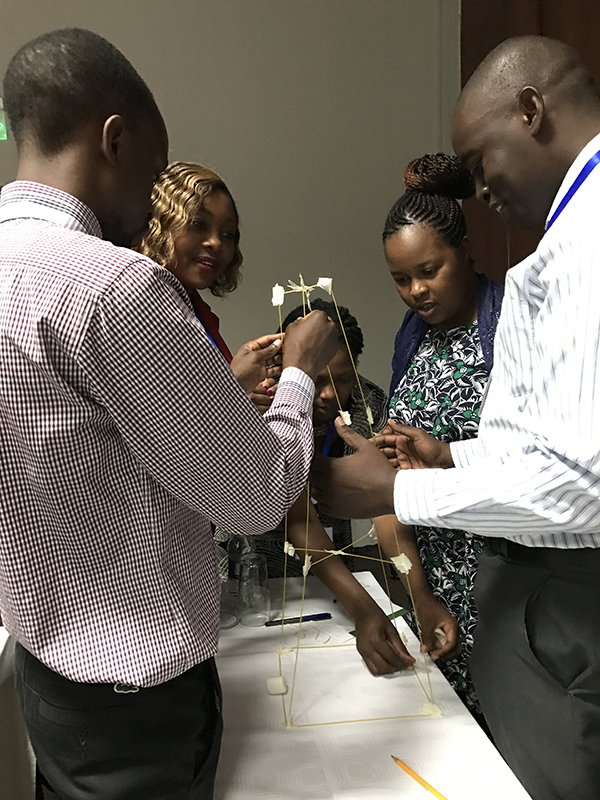Session 5: How to Coach on Generating Ideas for Change and Testing Ideas with PDSA
In this session you will review the Plan-Do-Study-Act (PDSA) concept, and how to coach teams in generating ideas to drive improvement, testing those ideas, and documenting what works and what does not.
Getting Ready For This Session
- Remember to have your workbook and a pen or pencil handy.
- You will need about 80–90 minutes to complete the session. You may want to break it up into smaller chunks of time.
Learning Objectives
At the end of this session, learners will be able to:
- Help a QI team to generate change ideas in a quality improvement project
- Coach a team in using the driver diagram to understand the influences that drive improvement
- Explain what the abbreviation PDSA stands for
- Coach a team through the process of conducting and documenting PDSA cycles
Learning Activities
-
Introduction (2 min)
Hooray! You have made it to the major action portion of QI. By now, your team has been formed and has identified the roles of its members, defined and clarified its improvement aims, explored the baseline situation of the problem being addressed, and analysed possible causes of the problem. Along the way, ideas have emerged around possible ways to drive improvement. Perhaps you have been tracking these using a list—or a ‘parking lot’, as we saw in the last session.
At this stage, your team will further generate change ideas, and then spend some time prioritising the changes it will test. Once the team has prioritised the ideas it has generated, it will conduct PDSA cycles (PDSAs), testing the ideas to see which ones drive improvement.

-
Pre-test Self-assessment (10 min)
Let’s start with a brief pre-check of your knowledge of generating ideas for change and testing ideas with PDSA. Each question will have a score for you to track in your workbook. Please track your scores as you go through this assessment, and make note of any content areas that you answered incorrectly.
-
Marshmallow Challenge (7 min)
Before we dig into the session material, watch this TED talk by Tom Wujec about a team activity that involves spaghetti, string, and a marshmallow.1
As you watch, think about how this might relate to our work coaching QI teams. Write any thoughts you have in your workbook; we will revisit these ideas later in the session.
-
Where Do Change Ideas Come From? (7 min)
Now that your team understands the problem and has identified goals for improvement, it is time to generate more change ideas, and then prioritise which changes to test first. Ideas can come from a number of sources and activities. Tap the tabs below to see descriptions of some important sources.
Literature and evidence
Access and review what is known about the problem and the interventions that have been demonstrated to be effective (and those that have not). You can do your own search, or you might ask colleagues to suggest references that may also yield results.
Team expertise
QI team members and other colleagues on the larger clinical team will be some of the richest sources of ideas. Be sure to invite and welcome ideas from co-workers in different roles at all levels of authority.
‘Steal shamelessly’
The idea of stealing shamelessly implies that every idea that the team generates does not have to be completely new or original—many ideas can come from others; the field of QI encourages this. Here is a light-hearted graphic to show the basic flow of stealing ideas:

Reference: Adapted from Steal Like An Artist by Austin Kleon. (If you publish work that draws from the ideas of another person, remember to attribute those ideas to that person.)
QI tools
Use your team’s experience with problem analysis. The tools that the team worked through likely ended up generating a number of ideas. Hopefully, you have tracked these using either a ‘parking lot’ or a list. This would be a good time to review those ideas and add new ones to the list.
Another commonly used tool is the driver diagram, which helps the team to visualise the main ‘drivers’ towards the project goal. The driver diagram can be a helpful guide as you generate change ideas. (More on this concept below.)
Change concepts
A foundational book describing the Model for Improvement is The Improvement Guide: a Practical Approach to Enhancing Organizational Performance. Appendix A of this book contains ‘A Resource Guide to Change Concepts’, in which the authors list 72 broad approaches to change. IHI has listed these 72 concepts in a useful one-page resource. You can generate specific ideas from these broad concepts.
Change ideas can fall under different levels. Some ideas focus on health care workers and their roles in a process; in this context, change ideas may address increasing knowledge and understanding. Other ideas may focus more on the system and the process itself; here change ideas may address improving efficiency. Be aware of different levels of change as you coach the team—and seek ideas that address both levels, individual and system.
Change package
A change package is a collection of change ideas that have been shown to be effective towards achieving a specific aim as part of an improvement project. Change packages may already exist; these are great sources for ideas to ‘steal’. One reason to thoroughly document the improvement project, including each PDSA cycle, is that you can use your own project experience to develop a change package. This approach can help sustain the progress the team has made; it can also be shared with other teams.
Creative thinking activities
Creative thinking activities can help the team generate new ideas that may be worth testing. As a coach, you can use your own creative thinking to help the team brainstorm. Some creative thinking ideas are listed below.
- ‘What if’ exercises (sometimes called ‘provocation’).
- Written brainstorming.
- Analogies and free word association. Ask team members to compare the problem or issue to seemingly unrelated objects or words.
For example, What if we did the process in reverse? What if we thought of the perfect possible.For example, each person has three minutes to write down ideas. Each person passes their sheet of paper to the next person, who then has three minutes to add more ideas.For example, If the problem were an animal, what kind of animal would it be?Once the team has listed a number of change ideas generated through aim setting, problem analysis, and brainstorming, it can begin to decide which ideas to try out, and which ones to keep in a ‘parking lot’ for later.
Our colleagues at LARC have included a useful tool in the Clinic-Lab Interface project to help teams go through this prioritisation process: the Impact/Effort grid.
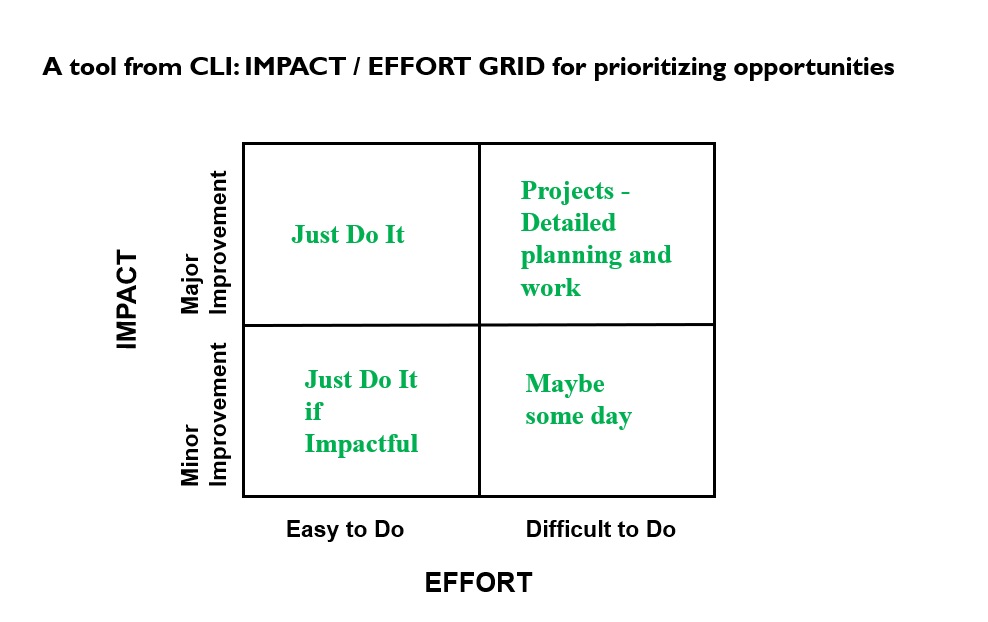
-
Understanding the Driver Diagram (3 min)
One of the QI tools that may be useful at this point in the process is the driver diagram (sometimes called a ‘key driver diagram’). This is another way of looking at the things that help the programme achieve its aims.
Let’s listen to Edson as he describes using the driver diagram.
-
Using the Driver Diagram (5 min)
Now we will use your understanding of the components of the driver diagram to identify these components using an example related to HIV viral load testing.
-
Creative Thinking Activities (3 min)
Here are some basic guidelines for discussing change ideas, brainstorming and creative thinking. Let’s listen to Alex as she introduces creative thinking activities to the team.
Transcript

Hi everyone, I am so happy to see you all here today. I want to spend the next few minutes introducing you to an activity that we will do together. I am going to be asking you to brainstorm, think outside of what you normally do, and even to come up with wild ideas.
Let’s make sure our team is encouraging and it is safe for everyone to come up with ideas. Remember that no one is being judged, no scores are being kept, this will not impact your status at work. The main thing is that you allow yourself to be creative in your ideas.
Here are a few group rules for us to follow: first, no criticism—that means we are all open to any ideas that are brought to the table. You never know if a way-out thought is a trigger for something more actionable, so let’s feel free to be creative. We will keep the process fairly fast-moving. Let’s generate lots of ideas before we comment on them or try to make them actionable—just remember to keep the ideas focused on the topic. Before we get into the particulars, I want to ask you whether you are more comfortable writing individually, or prefer to speak out with a notetaker?
AlexHere are some key points to keep in mind when working with your team on creative thinking activities:
- Set a quick pace and time limit.
- No criticism—establish a tone that says all ideas are welcome, no matter how outrageous they may seem. Seemingly outrageous ideas may contain the seeds of a useful idea.
- Instruct the team in the thinking activity.
- Write all ideas on sticky notes or a flip chart, praising the ideas and input of the team members as you go along.
- After all ideas have been generated, group them in categories, merge any duplicates, and begin to describe the remaining ideas in more detail. See if they can be turned into actual change ideas to test.
-
Creative Thinking (5 min)
Some of these activities to generate change ideas will call on participants to ‘think outside the box’ and share ideas in the group.
Think about creative thinking activities you have experienced in the past, whether as a coach or as a participant.
Based on your experience, write answers to the following questions in your workbook:
-
PDSA (7 min)
Now that the team has identified and prioritised some change ideas, it is time to test the ideas using PDSA cycles. This narrated slide presentation summarises key points about conducting PDSAs.
Note that this is a previously recorded session. You will not be able to tap on any of the links that are mentioned.
-
PDSA Documentation (2 min)
As we have emphasised, it is very important to document QI project activities. There are many QI project tracking tools available, of which we have provided one example here. Your team can decide which tool is the most useful and the most feasible to maintain over the course of the project.
It is important to document each PDSA cycle, so that the team can understand which interventions work and which do not. When properly documented, you can develop a change package based on your own project experience. This approach can help sustain the progress the team has made; it can also be shared with other teams.
This PDSA tracking tool is in your workbook. Feel free to make copies to share with teams.
-
PDSA Experiences and Issues (5 min)
Take a moment to think about your experiences with QI activities, either as a coach or as a team member. Write responses to the following questions in your workbook.
-
Reflecting on the Marshmallow Challenge (3 min)
Here are some photos of the I-TECH Zimbabwe team participating in the marshmallow challenge a few years ago.
-
Omega Clinic: Testing Ideas (10 min)

At Omega Clinic, recall that the QI team has conducted its problem analysis, and now is beginning to look at possible change ideas to test.
From the last session, you may recall that the QI coach, Sekai, engaged the team in a process mapping activity that yielded some great ideas to test. Some of these ideas were:
- Sensitise clients at all entry points.
- Have facility linkage facilitators escort clients to the EICT focal person.
- Place a ‘counselling in progress’ notice on the door of the index testing room.
All of these ideas can be reviewed on the process map. (Be sure to view all pages of this document.)
Sekai arranged a time to meet with the QI team at its convenience—at a time when clinic was not open—so that team members would be able to attend the meeting. She wanted to engage the team in some creative thinking activities before beginning to test ideas using PDSA.
She started with 3–3–3 brainstorming because she wanted to give the team members time to think of ideas without feeling pressured to speak. She also added some questions to the exercise to help spark the team’s imagination: She invited them to write what kind of animal the problem would be, what colour the problem would be, what food the problem would be. She assured the team members that there would be no judgement for outrageous ideas, that this was simply an exercise to see if the team could generate some additional ideas.
After adding another change idea to their list—posting index testing job aids to clarify steps—the team began preparing to conduct PDSAs to test their ideas. They decided that the first idea they would test would be the one likely to have the greatest impact with the least amount of effort.
-
Post-test (10 min)
Now that you have completed this session, let’s finish with a quick check of your knowledge and comfort around how to coach on generating ideas for change and testing ideas with PDSA. Each question will have a score for you to track in your workbook. Please track your scores as you go through this assessment, compare them with your pre-test scores, and make note of any content areas where you answered incorrectly.
How did your post-test score compare to your pre-test score? If you found that you had some gaps in your knowledge or understanding, think about what you can do to fill in those gaps for yourself, and what resources you can access.
-
Summary (2 min)
In this session, we discussed the process of generating ideas—using ideas that have emerged from problem analysis, and those that come as a product of creative thinking activities. We reviewed prioritising which ideas to test, and then conducting PDSA cycles—testing the change ideas to see which ones drive improvement. Finally, we continued to emphasise the importance of documenting these activities by using the PDSA tracking tool and run chart.
Take a few minutes to fill in the next section on the Action Plan in your workbook, list some of the activities that you will conduct as you are working with the QI team to generate ideas for change and conduct PDSAs.
-
Additional Resources
Here are some of the resources you can access on this topic. Remember, if you need additional support or information, contact your supervisor or QI coordinator.
Title/Source File IHI video on driver diagrams
(requires an internet connection)Click to open file. Impact Effort Grid Click to open file. PDSA tracking tool Click to open file. EICT Driver Diagram example Click to open file. IHI Using Change Concepts to Come Up with Ideas Click to open file. Action Plan Template Click to open file.
Footnote references
- Tom Wujec: Build a tower, build a team | TED Talk. Retrieved August 6 2021 from TED


